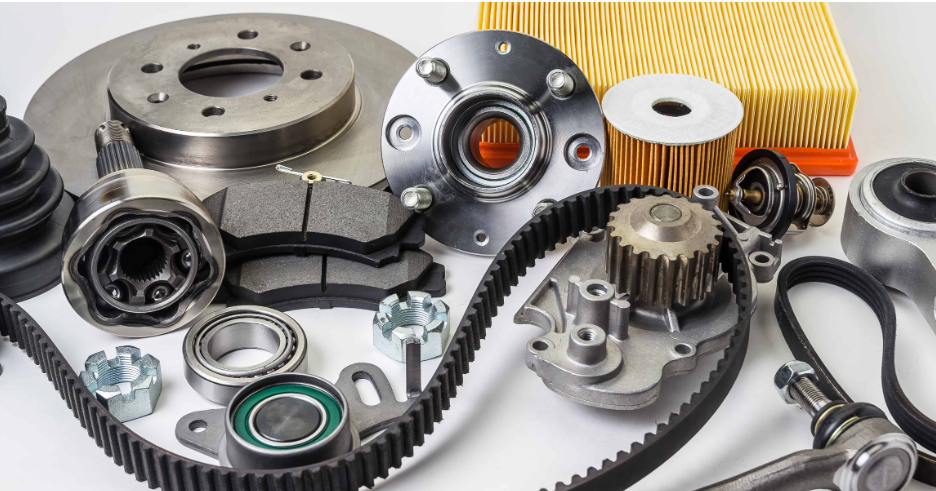Understanding Truck Brake System Components
In the heavy-duty trucking industry, brake system components play a crucial role in ensuring safe transportation. Key parts such as brake pads, rotors, drums, and calipers are essential for effective braking and maintaining control over truck movements. Brake pads are responsible for converting kinetic energy to heat and reducing speed, while rotors and drums provide the surface on which the pads apply pressure to initiate this deceleration. Calipers, in turn, hold the brake pads in place and exert pressure on the rotors. These components collectively work to ensure that trucks can safely stop, even under heavy loads.
When discussing air brake systems versus hydraulic systems, each has its distinct characteristics and applications. Air brake systems, primarily used in heavy trucks, rely on compressed air to exert force on brake pads, while hydraulic systems use fluid pressure to achieve the same result. According to studies by trucking organizations, the average lifespan of air brake components like compressors and air tanks ranges from three to five years, while hydraulic systems vary considerably based on usage and maintenance.
Moreover, the importance of quality truck fuel pumps cannot be overlooked in supporting the braking system's functionality. Fuel pumps are vital for providing the engine with sufficient fuel to remain operable when braking, especially in emergency situations. Regular inspections and replacement schedules contribute to the increased reliability and safety of these complex systems.
How Drum Brakes and Air Disc Brakes Differ
Understanding the differences between drum brakes and air disc brakes is essential for optimizing maintenance strategies for truck brake systems. Drum brakes utilize friction between the brake shoes and the brake drum to create deceleration, while air disc brakes employ pads that press against a rotor. Drum brakes are advantageous for their durability and capacity to withstand heavy loads, making them ideal for long-haul trucking. However, they require frequent adjustments and maintenance to remain effective.
On the other hand, air disc brakes are lauded for their superior performance in terms of stopping power and heat dissipation. They provide shorter stopping distances compared to drum brakes, and their maintenance is simpler due to fewer moving parts. However, air disc brakes may incur higher initial costs and require specialized knowledge for repair.
Studies comparing the braking efficiency and stopping distances reveal that air disc brakes can reduce stopping distances by upwards of 30% compared to drum brakes. Despite this advantage, drum brakes remain popular in certain sectors due to their cost-effectiveness and reliability under continuous heavy-duty usage.
Essential Brake Inspection Procedures
How to Check Brake Linings and Pads for Wear
Inspecting brake linings and pads is an essential procedure in maintaining truck safety. The correct method involves a detailed visual and tactile assessment. It's important to look for any uneven wear and check for minimum thickness levels based on your truck's specifications. Maintenance manuals advise that the minimum thickness for brake pads in commercial trucks should not fall below the industry-standard guidelines of approximately 1/4 inch. Regular inspections not only help in confirming these standards but also in preemptive maintenance, preventing costly repairs and ensuring optimal braking efficiency.
Testing Slack Adjuster Functionality
Evaluating the slack adjuster's effectiveness is a pivotal aspect of brake maintenance. To do this, a step-by-step process should be followed: Start by verifying the adjustment angle and confirming the correct alignment. Next, manually check the adjusters for wear, ensuring they aren’t out of sync as this could lead to system malfunction. Data shows that inadequately adjusted slack adjusters significantly impair braking efficiency, thereby elevating accident risks due to increased stopping distances. Routine checks ensure adjusters are in perfect working condition, reducing potential hazards.
Air System Leak Detection Methods
Detecting air leaks within the braking system can be accomplished through several methods. Listening for leaks, applying a soap solution, and using pressure gauges are effective techniques to identify issues in the air system. Experts recommend conducting routine leak inspections, ideally every 30 days, to ensure proper pressure levels within the braking system. Such regular checks help in maintaining system integrity and functionality, averting potential breakdowns due to unnoticed leaks and ensuring the trucks’ braking systems remain reliable.
Preventing Common Brake System Failures
Avoiding Overheating in Downhill Braking
To prevent overheating during long downhill descents, it is crucial to manage brake temperature effectively. This can be achieved by employing engine braking strategies, which reduce usage of service brakes, thus minimizing overheating risks. Statistics from industry studies indicate that a significant number of brake failures in heavy-duty trucks result from overheating, particularly in hilly regions. By incorporating techniques such as using a lower gear and monitoring brake temperature consistently, truck drivers can significantly mitigate risks associated with brake overheating and enhance overall road safety.
Recognizing Signs of Wheel End Damage
Detecting wheel end damage early is essential for maintaining truck safety. Visual signs like uneven tire wear or bearing leaks and audible signs like unusual vibrations or grinding noises serve as red flags for potential wheel end damage. According to accident reports, a notable percentage of crashes are linked to neglected wheel end maintenance, underlining the dangers it poses. For optimal safety, regular inspections and timely maintenance actions should be prioritized to prevent accidents and expensive repairs.
Interpreting ABS and Low-Pressure Warnings
Understanding the significance of ABS (Anti-lock Braking System) warnings and low-pressure alerts is vital for maintaining brake system performance. An ABS warning indicates issues with preventing wheel lockup, which can compromise vehicle control, while low-pressure alerts signal potential brake failure risks. Operators should take immediate action by inspecting for leaks or sensor malfunctions. Experts recommend routine checks and prompt response to these warnings to ensure that the braking system remains functional and effective, reducing the likelihood of braking mishaps.
Maintenance Strategies for Optimal Brake Performance
Routine Service Intervals for Heavy-Duty Components
Establishing routine service intervals for brake system components is crucial for maintaining heavy-duty truck safety and performance. Generally, it's recommended that brake pads be inspected every 20,000 to 30,000 miles, though this can vary based on the truck's usage type and operating conditions. For brake rotors and drums, an inspection every 50,000 miles ensures timely identification of wear patterns or damage. Regular service intervals, aligned with industry standards, help ensure that brake systems remain reliable. Such proactive maintenance not only adheres to a truck maintenance schedule but can also significantly reduce the risk of unexpected failures on the road.
Best Practices for Air Dryer Maintenance
Air dryers play a crucial role in maintaining truck brake performance by preventing moisture-related issues. It's essential to regularly replace the air dryer desiccant cartridge every 100,000 miles or annually to ensure its effectiveness. Keeping the air supply system free of leaks is also vital. Common pitfalls in neglecting air dryer maintenance include increased moisture in the air system, leading to brake lining damage and reduced braking efficacy. By adhering to best practices, you can prevent these issues and enhance your truck's braking reliability.
When to Replace Brake Rotors and Drums
Determining when to replace brake rotors and drums is essential for ensuring safe and effective braking. Rotors should be replaced if their thickness falls below the minimum specified by the manufacturer, or if there are signs of warping or severe grooves. Drums also require replacement when they become too thin or exhibit scoring. In typical heavy-duty truck applications, the lifespan of rotors and drums can range from 50,000 to 70,000 miles, depending on driving conditions. Keeping track of these metrics is an integral part of truck maintenance, emphasizing the need for timely intervention to maintain optimal brake performance.
Preparing for Brake Safety Week Inspections
Documentation Requirements for Compliance
When gearing up for Brake Safety Week inspections, having the proper documentation is crucial. Compliance requires keeping maintenance records, service logs, and compliance checklists to demonstrate routine vehicle care. According to guidelines by regulatory bodies, these documents must be accurate and current. The Commercial Vehicle Safety Alliance (CVSA) emphasizes that accurate documentation reflects a commitment to safety and maintenance. It's essential to include records of brake inspections, repairs, and any parts replacements. Ensuring these documents are ready not only helps in smooth inspection but also in establishing credibility regarding braking systems' upkeep.
Pre-Trip Checklist for Brake Systems
Creating a thorough pre-trip checklist is a proactive measure in ensuring brake system functionality. The checklist should cover components such as brake pads, rotors, drums, and the air dryer system. Routine checks help detect potential malfunctions that could lead to unexpected breakdowns on the road. Evidence by trucking industry studies suggests that regular inspections can significantly reduce the risks of brake failures, enhancing both safety and performance. By systematically examining each aspect of the brake system before every journey, truck operators can maintain the reliability of vital heavy-duty truck parts, ensuring smooth operations and compliance with safety norms.
Understanding CVSA Inspection Criteria
Understanding the CVSA inspection criteria is essential for maintaining compliance during Brake Safety Week. The CVSA sets specific standards that focus on brake components, air systems, and overall vehicle safety. Non-compliance can lead to significant consequences, including heavy fines and out-of-service violations. Furthermore, industry experiences highlight how non-compliance with these criteria can impact safety regulations and operational efficiency. Truck operators must ensure their braking systems meet or exceed these standards, not just to avoid penalties but to contribute actively to road safety. Being well-versed with the CVSA criteria ensures preparedness and adherence to leading industry safety practices.







